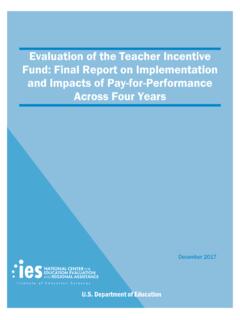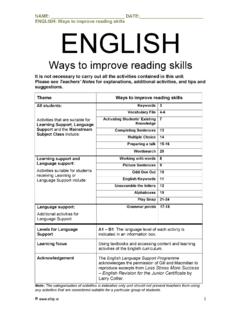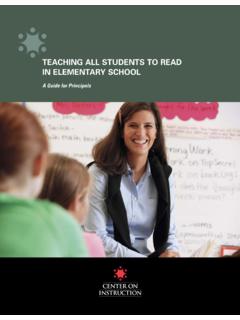Transcription of Tips for Supporting Reading Skills at Home - ies.ed.gov
1 NCEE DEPARTMENT OF EDUCATIONEDUCATOR S PRACTICE GUIDE A set of recommendations to address challenges in classrooms and schoolsWHAT WORKS CLEARINGHOUSE Foundational Skills to Support Reading for Understanding in Kindergarten Through 3rd GradeTips for Supporting Reading Skills at HomeFour Tips for Supporting Reading Skills at Home:K1231 Have conversations before, during, and after Reading together2 Help children learn how to break sentencesinto words and words into syllables3 Help children sound out words smoothly4 Model Reading f luently by practicing Reading aloud with your childAppropriate for children in gradesWhat Works Clearinghouse About Tips for Supporting Reading Skills at HomeThese tips help parents and caregivers carry out the recom-mended practices described in the Institute of Education Sciences Educator s practice guide, Foundational Skills to Support Reading for Understanding in Kindergarten Through 3rd Grade.
2 Each tip highlights evidence-based practices from classroom settings that could also help parents or caregivers develop their children s Reading at home. A panel of experts developed the practice guide. The authors of the practice guide are Barbara Foorman, Nicholas Beyler, Kelley Borradaile, Michael Coyne, Carolyn Denton, Joseph Dimino, Joshua Furgeson, Lynda Hayes, Juliette Henke, Laura Justice, Betsy Keating, Warnick Lewis, Samina Sattar, Andrei Streke, Richard Wagner, and Sarah DEPARTMENT OF EDUCATIONEDUCATOR S PRACTICE GUIDE A set of recommendations to address challenges in classrooms and schoolsWHAT WORKS CLEARINGHOUSE Foundational Skills to Support Reading for Understanding in Kindergarten Through 3rd GradeAbout the Evidence for Tips for Supporting Reading Skills at Home The evidence Supporting the practice guide recommendations comes from studies examining interventions in school-based settings.
3 Ther efore, although the practices described in the tips might be effective in home settings, we did not assess studies of these practices involving parents or care givers at home. For more information about the evidence for these practices, see the Summary of Evidence for Tips for Supporting Reading Skills at the What Works ClearinghouseThe What Works Clearinghouse (WWC) reviews the existing research on programs, products, practices, and policies in education. Our goal is to provide educators with the information they need to make evidence-based decisions. We focus on the results from high quality research to answer the question, What works in education? More information is available at Practice GuidesThe Department of Education s Institute of Education Sciences (IES) publishes Practice Guides in education to provide educators with the best available evidence and expertise on current challenges in education.
4 The WWC develops Practice Guides in conjunction with an expert panel, combining the panel s expertise with the findings of existing rigorous research to produce specific recommendations for addressing these guides published by IES are available on the WWC website at conversations before, during, and after Reading togetherThese activities are typically appropriate for children in kindergarten through third conversations when Reading with children helps them develop higher-level thinking and language Skills , such as predicting, problem solving, or contrasting. While Reading books aloud, ask the child questions and talk about the content of the story together before, during, and after Reading . Use open-ended questions to ask the child to think about the book s messages and what is happening.
5 See the box below for examples of questions to ask children when Reading different types of books. Ask the child to apply the book s messages to the world around him by connecting events to his own life. Ask more and more complex questions, so the child continues to build her vocabulary and language Skills . What would happen if you planted a tree in the desert? Why do birds fly south for winter? Why is it important to recycle?Example questions forinformational booksthat explain facts about the world, such as books about animals ? Why did the character do what he did? What else could she have done? If you were in that story, what would you have done?Example questions fornarrative booksthat are about a series of events, whether fictional or nonfictional,such as storiesWhat Skills will this practice help build?
6 Having conversations about what they are Reading helps children build vocabulary and develop Skills using language typically found in school settings. Building their Skills to think and connect ideas from many contexts allows children to follow more complex language, which they might find in stories, instructions, and descrip-tions of historical events or nature. What Works Clearinghouse 2 Help children learn how to break sentences into words and words into syllablesThese activities are typically appropriate for children in kindergarten and first children can identify letter sounds in words or Reading , they can learn how spoken language can be broken down into smaller pieces. Show children that they can break down sentences into words. o Practice identifying the words in a sentence by saying a sentence aloud and asking the child to count the number of words in that sentence.
7 O For instance, have the child count the number of words in the sentence The boy ate two pieces of pizza and correct any mistakes. Talk about how to combine two words to form another word and about how some words can be broken into smaller words. The box below shows a conversation about : Sometimes you can put two words together to form another word. For example, if I put straw and berry together, I get strawberry. What do you get if you put book and shelf together?Child: : That s right! You can also break some words into smaller words. What do you get if you take the cow out of cowboy? Child: Boy?Adult: That s right!After children can identify words in sentences, they can begin to break words into syllables. Here are two examples of how to show breaking words into syllables:1.
8 Place your hand under your chin and notice the number of times your chin moves down as you say a word Hold up a finger for each syllable as you say a showing these strategies, have the child practice finding syllables in familiar words. A syllable is a part of a word that has one vowel sound. One or more letters can be the vowel sound, and a consonant may or may not come before and/or follow it. For example, the word banana has three syllables: Skills will this practice help build?Learning how to identify words in sentences and syllables within words helps children understand how to break down the sounds within spoken language. Identifying parts of speech such as words and syllables will prepare children to learn about smaller sounds tied to specific letters.
9 These are Skills that a child can practice even before he or she has started Reading or identifying letter sounds in Works Clearinghouse 3 Help children sound out words smoothlyThese activities are typically appropriate for children in kindergarten through third out a word involves saying the sound of each letter or letter combination one by one until the end of the word, and then saying them all together again quickly. Help children sound out words by: Showing how to say each letter sound in a word, starting at the left-hand letter and moving right, and then joining all the sounds together to form the word. Stretching and connecting sounds together as much as possible. The box below shows an example of how this might sound. Reminding children to check their pronunciation after they connect the sounds together.
10 For example: o Ask if the word makes sense or if it is a real word. o Ask if they know the word that they said after saying the letters all together quickly. o If the word is not familiar, ask them to read the word again to make sure they joined all the sounds together correctly. Sounding out words smoothly helps children remember and combine sounds to arrive at the correct word. Here is an example with the word man: Adult: How does this word start?Child: /mmmm/Adult: Then what s the next sound?Child:/aaaaa/Adult: And then what sound comes next?Child: /nnnnn/Adult: What happens when you put them together?Child: /mmmmaaaannnn/Adult: What is the word?Child:Man!What Skills will this practice help build? Recognizing and manipulating sounds that are part of words and linking those sounds to letters is necessary to prepare children to read words and understand what they are Reading .



















